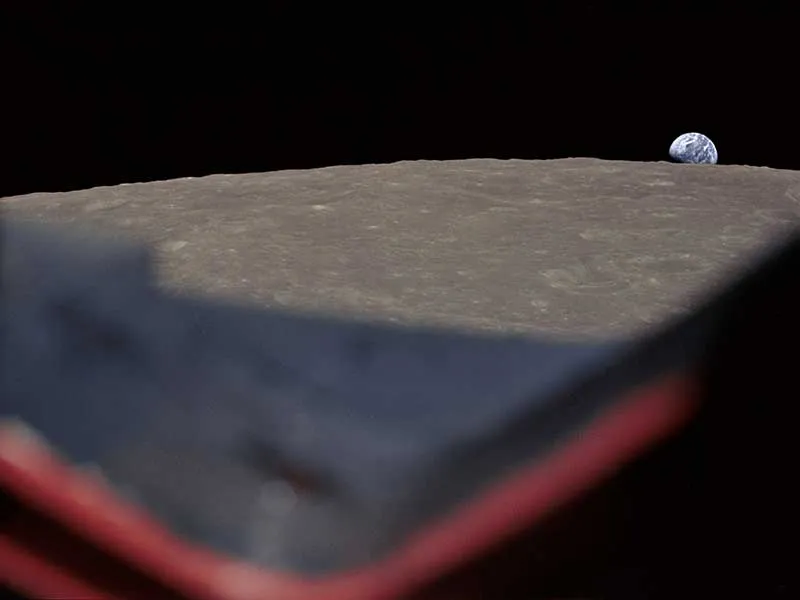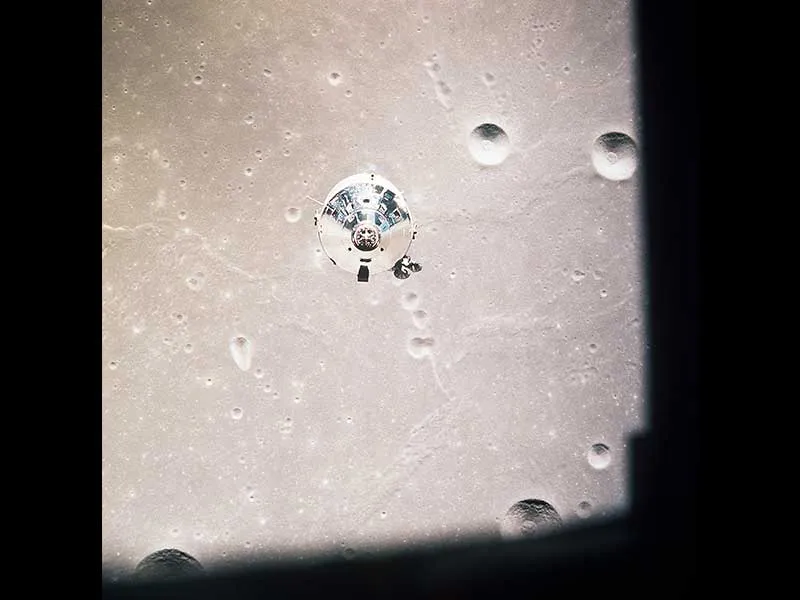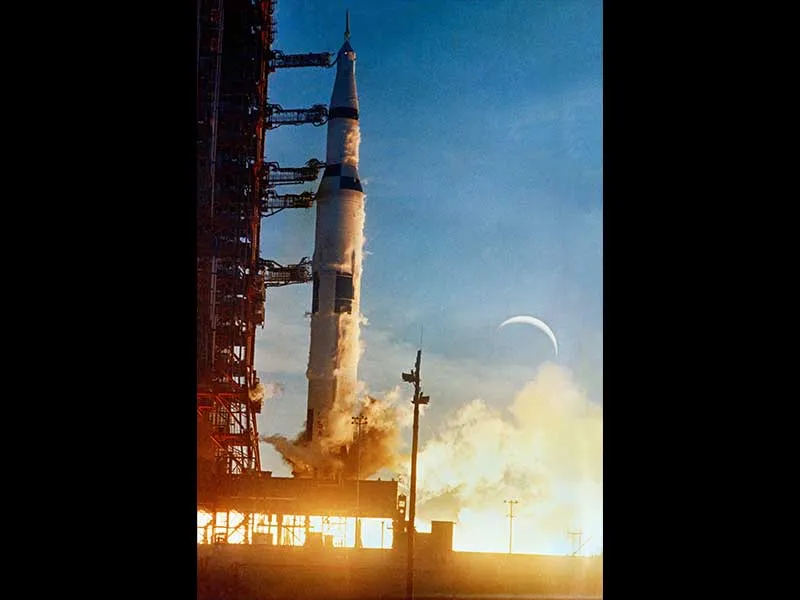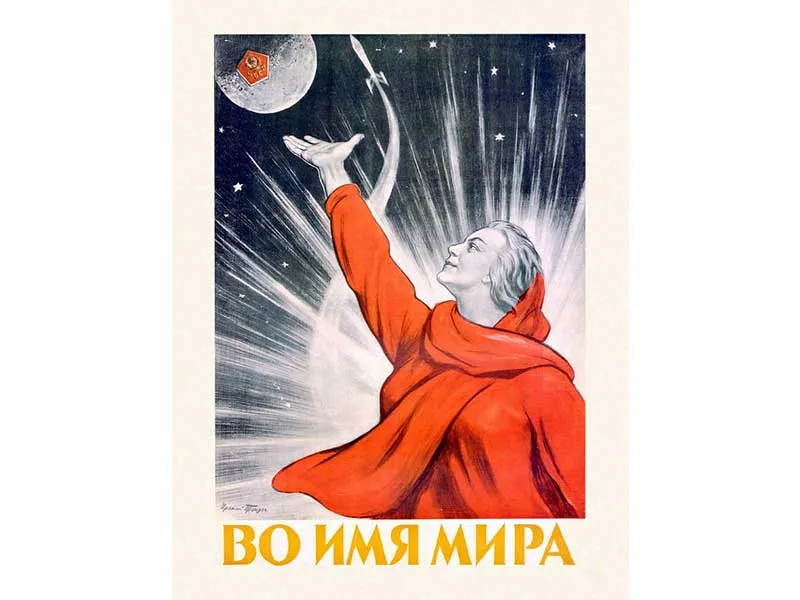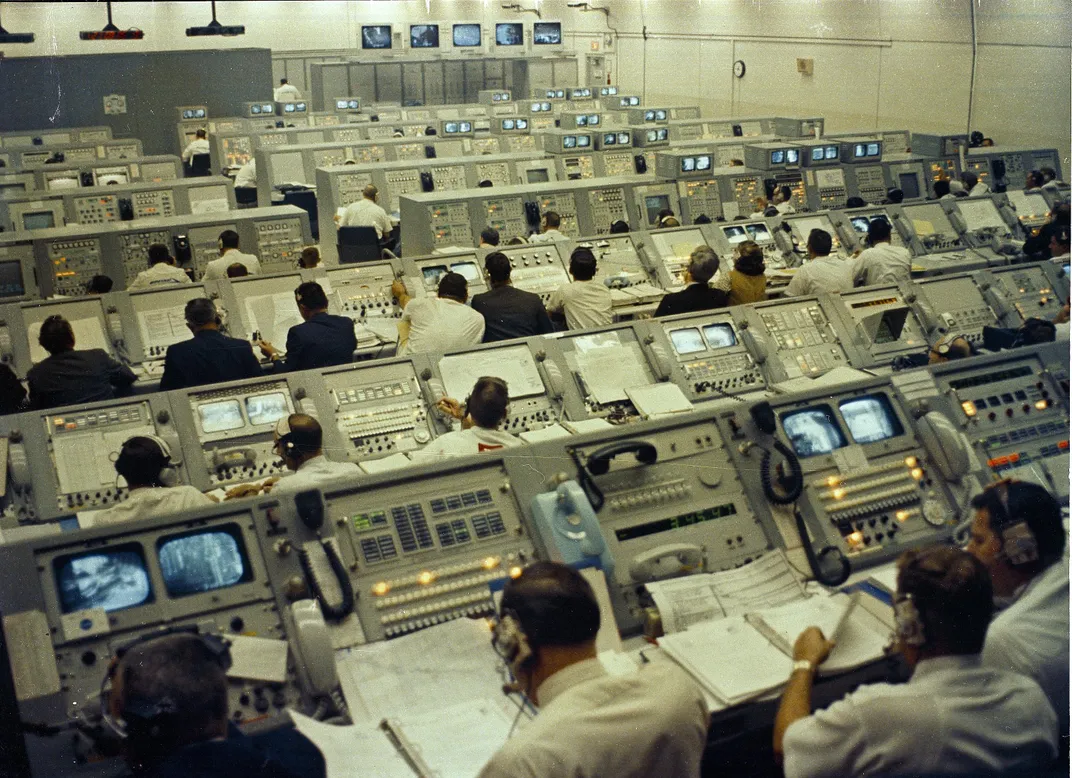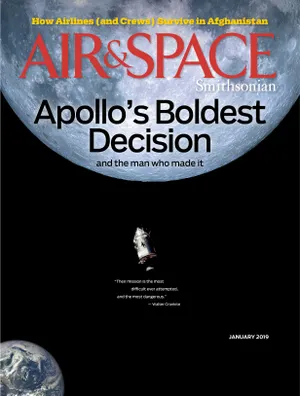The Man Who Won the Moon Race
George Low’s idea to shoot for the moon in 1968 may have been Apollo’s boldest decision.
/https://tf-cmsv2-smithsonianmag-media.s3.amazonaws.com/filer/b3/f2/b3f23714-f843-44ef-a356-0ff81483ca31/06a_dj2019_georgelow1965_pressconferences65-60002_live.jpg)
For its annual “Man of the Year” cover on January 3, 1969, Time magazine made the rare choice to honor not just one individual but three: NASA astronauts Frank Borman, James Lovell, and William Anders. Their Christmastime lunar voyage on Apollo 8 had been, in the editors’ opinion, a “transcendent legacy” of 1968 and “a journey into man’s future.”
The magazine’s editors also called out for special recognition a single “groundling” from the 400,000 or so people working on Apollo at the time: a 42-year-old, Austrian-born NASA manager named George Low. The name was practically unknown to the public, but had it not been for Low, Time proclaimed, “there would have been no Apollo 8 flight to the moon.”
The editors could have gone further. Without Low, President John F. Kennedy may never have committed the nation to a lunar landing and once committed, may never have recovered from the Apollo 1 fire that had brought the program to a standstill less than two years before Apollo 8’s triumph.
Compared to Apollo-era giants like Wernher von Braun and Neil Armstrong, Low still remains mostly unrecognized. But his reputation has grown with time. “As usual with any great endeavor, it always boils down to a single human being who makes a difference,” Apollo 8 commander Frank Borman said during a panel discussion almost 50 years later. “In the case of Apollo, the person in my mind who made the difference was George Low.”
Born near Vienna between the world wars, George M. Low was part of an influential family that at one time operated Austria’s largest industrial alcohol refinery, fertilizer factory, and export business. In 1938, 12-year-old George, his mother, and two siblings fled the Nazis (his father had died four years earlier) and emigrated to the United States, eventually settling on a farm in upstate New York. In their adopted country, Gertrude Low raised her son not to focus on the past, or on what might have been.
Calm, quiet, and intensely focused on whatever he was doing at the moment, the boy had an affinity for mathematics and mechanical tasks. He remained throughout his life a self-described “dirty-hands engineer.” Even in some of his busiest years at NASA, his family could not recall a single time that he called a repairman. Once, when the washing machine broke, Low spent an entire Saturday disassembling it and spreading all the parts across the wet floor, until he found the one damaged piece.
Low attended Rensselaer Polytechnic Institute in Troy, New York, just as the jet age was about to get under way. “Fun is one of the main reasons for doing anything,” he believed, and he found plenty in the field of aeronautics. He was drafted into the Army Corps of Engineers while still an undergraduate but eventually returned to Rensselaer to finish his master’s degree. In 1949, the same year he got married, Low landed a job working as an aeronautic research scientist for Abe Silverstein at the National Advisory Committee on Aeronautics (NACA) Lewis Research Laboratory outside Cleveland.
Under Silverstein, Low did foundational research on basic aeronautic problems such as boundary-layer flows and high-speed turbulence, at a time when the NACA was assisting the Air Force in the classified X-plane program. It was in the course of this work that he first crossed paths with a young test pilot and engineer named Neil Armstrong.
When, in 1958, Silverstein moved to Washington, D.C., to become director of Space Flight Programs at the newly created National Aeronautics and Space Administration, he took Low with him. Along with pioneering space engineers Bob Gilruth and Max Faget, Low was assigned to the agency’s human spaceflight initiative, Project Mercury. While he would have preferred being involved directly with the engineering work, Low was needed to manage the business side of the program, as head of NASA’s Office of Manned Space Flight (OMSF).
Right away, Low had an impact. “George was good at everything,” Gilruth recalled in a 1987 interview. “He was worth about 10 men.” George Abbey, Low’s technical assistant during Apollo who would go on to oversee the astronaut corps in the space shuttle era, remembered that his boss “was at work long before most people in the morning and long after they left at night.”
Low’s attention to detail, and his nearly photographic memory, were legendary. A Washington Post reporter marveled, “Low reads every piece of paper that goes through his office. He feels he has to touch everything to assimilate it. But once he does, he never forgets it.”
Perhaps because English was his second language, Low developed a mathematician’s precision with words. He used a green felt-tip marker to edit and comment on everything he read, so that his notations would stand out and so people would instantly recognize them as his. He even corrected grammar. The pens were known around the office as his “green stingers” or “green hornets.”
A significant part of Low’s job was testifying before Congress on everything from budget requests to whether the United States could beat the Russians in space. A licensed pilot, he had a special affinity with NASA’s astronauts and would introduce them around to the power players on Capitol Hill. Low had helped come up with the criteria for selecting the Mercury Seven, and he viewed the astronauts’ test pilot experience as critical for mission success. “They were the hardest-working bunch of guys I ever knew,” Low once said.
When it came to politics, he was a pragmatist rather than an ideologue. Any cold war calculations regarding Apollo he left to the White House and Congress. He was, however, naturally competitive. Low hated to lose, whether it was a game of tennis or a geopolitical race against the Soviets to the moon. “One of the deepest disappointments to me was when I got a phone call, the night of April 12 [1961], at 2:00 a.m., telling me that Gagarin was up,” Low recalled later. The Mercury spacecraft had been ready to launch Alan Shepard a few weeks before that. But Wernher von Braun and his rocket team in Alabama, as well as some at NASA headquarters, were concerned about an anomaly that had cropped up on an earlier unpiloted test. “Gilruth and I were ready to go,” Low said. “We knew what the problem was, and we were sure we had it solved.” After a tense meeting in Washington to make the go/no-go decision, another animal test flight was ordered, just to be safe. Low was disappointed, but he was never one to slam the desk or raise his voice. When he was mad, his colleagues noticed, he went quiet, and his language became more precise and exacting. He accepted the delay to Shepard’s flight while always regretting what he called “a political decision.”
* * *
In those early days of human spaceflight, Low was one of the principal advocates for a lunar landing as a worthy goal for NASA. In April 1959, as a member of the so-called Goett Committee charged with producing a long-range strategic plan for the agency, Low pushed for the moon. (One writer even went so far as to call him a “Moon Zealot.”) Unlike von Braun or some other early NASA figures, he wasn’t inspired by childhood dreams of flying rockets into space. Rather, it was the dirty-hands engineer in him that viewed a moon landing as a technically challenging—and therefore exciting—target, one that would advance technology the furthest.
When other committee members suggested that a trip around the moon, rather than a landing, would be more prudent, Low, the natural competitor, persisted. He thought that both could figure in a multi-decade program. Circumlunar flight could come first, but it would be followed by a landing sometime in the 1970s.
On July 28, 1960, he presided over NASA’s first planning session to solicit feasibility studies for lunar missions. The meeting was attended by more than 1,300 representatives from government, the aerospace industry, and academia. It was here that Low first introduced the program his boss Abe Silverstein had dubbed “Apollo.” At a time when NASA rockets were still blowing up on the pad, Low held the crowd rapt as he spelled out Apollo’s modular approach to landing humans on the moon.
The press loved the story. The White House, not so much. President Eisenhower viewed human spaceflight as nothing more than a stunt, and Mercury as a one-time program rather than the start of some grand new enterprise. His response was to immediately erase all funding for astronaut flights from NASA’s 1961 budget. It took both NASA administrator Keith Glennan and deputy administrator Hugh Dryden to calm the president down. They were able to persuade him to restore funding—but without a lunar landing mission.
Low would not be deterred. In fact, he doubled his efforts to make sure NASA’s plans for human spaceflight didn’t end with Mercury. “I felt it would be important to have something in the files,” he said. “We needed to be prepared to move out with a bigger program, should there be a sudden change of heart within the government and with the administration.”
Low wrote Silverstein a memo on October 17, 1960, requesting a small working group—later to be called the Low Committee—to come up with a “proper justification” for the moon program and give it “a firmer foundation” in terms of technical and budgetary requirements. Silverstein approved with a simple “O.K.” written on the memo.
Less than four months later, on February 7, Low’s committee produced a detailed report on methods for getting to the moon, along with schedules and rough budgets. With proper funding, the report asserted, a lunar landing could be accomplished by the end of the decade.
While the team had been busy working on its study, the country had elected a new president, John F. Kennedy. Within a few weeks of his inauguration, the White House was looking for a PR boost in the aftermath of the Bay of Pigs fiasco. “When President Kennedy’s White House called up [NASA administrator] Jim Webb and said, ‘Now, what about this moon mission?’ NASA already had the answers, primarily through the work of the Low Committee,” recalled Max Faget. It was, in fact, George Low’s plan that became the foundation for Kennedy’s “by the end of the decade” challenge.
* * *
Six years later, when the Apollo 1 fire took the lives of three astronauts and put the moon program’s future in doubt, NASA once again turned to Low. In April 1967, Webb tapped him to be the Apollo program manager.
In a BBC interview more than a decade later, Low confessed he had found the accident “appalling.” He was convinced it never should have happened. The evening of the fire he had been in his office in Houston, working late and listening over a squawk box to the test under way at Cape Canaveral. It was clear things were not going well. Then, the first muffled sounds of tragedy: “Fire!” Low rushed over to Mission Control, where a call soon came: The astronauts were dead. When Low reached NASA deputy administrator Robert Seamans in Washington on the phone a few minutes later, he was so upset that Seamans couldn’t understand him at first. It was a rare show of emotion, something most of Low’s colleagues had never seen.
His anger and frustration quickly turned into a steely resolve to fix Apollo’s problems. “It was the most challenging time in my life as an engineer,” he told the BBC interviewer. Assigned the job of redesigning and rebuilding the Apollo vehicle, he and his team of NASA and contractor personnel set out “to find out what else lurked in that spacecraft and what else could come back to bite us.” All the while, he was aware of the clock ticking on Kennedy’s challenge. From April 1967 to the end of the decade, there would be just 33 more new moons. “It was a very countable number of times that the moon was going to be in the right position,” Low said.
During this period, he typically put in 18 hours a day, seven days a week. “My briefcase was my office; my suitcase, my home, as I moved from Houston to Downey, to Bethpage, to Cape Kennedy, and back to Houston again,” he recalled. He tried to reserve Sunday mornings for church and family. A reporter who profiled Low during this period wrote, “He has five children, ranging in age from 4 years old to 15, and they adore the elaborate manner he does everything for them on Sunday, from water-skiing to serving up pancakes for breakfast.” By Sunday evening, though, it was back to the telephone conferences and the stacks of paperwork, green pen in hand.
Low’s colleagues at the Manned Spacecraft Center had great faith in his leadership. “George Low was a master at getting people to work together,” recalled flight director Gene Kranz in a memoir. “The flight directors knew Low well from his middle-of-the-night visits to Mission Control during a flight, where he sat silently in the viewing room.”
He often took his lunch to sit with workers at the center and ask how things were going. The trust and respect went both ways. “You would do whatever he asked you to do, regardless of the odds and regardless of the risks,” said Kranz. “And you did so because you knew he sweated the smallest, most minute detail.”
Low knew that one of the fire’s overarching causes had been poor coordination of engineering changes to the Apollo spacecraft. Fixing the problem risked making things even worse. “Rebuilding meant changes, and changes meant trouble if they were not kept under perfect control,” he said. “Our solution was the CCB, the Configuration Control Board.” Its purpose: to keep close track of technical changes that could inadvertently affect some other part of the complex Apollo system.
Low saw to it that the board included “some of the best engineers in the world.” He demanded participation from every branch of the Apollo management and supply chain, including contractors like North American and Grumman. He assigned astronauts he trusted to be his eyes and ears at the shops where the spacecraft were being built. At Rockwell, he installed Frank Borman; at Grumman, Jim McDivitt.
“George got us [CCB members] all into a room,” recalled NASA’s head of flight operations Chris Kraft. “And he said, ‘All of you guys, the leaders—you will all attend. No substitutes. I don’t want anyone but you. You need to be on board 100 percent, because, together, we are going to run this program.”
The CCB met every Friday, promptly at noon, and rotated monthly between Rockwell and Grumman. The meetings often went late into the night, and no one left until all issues were resolved. From the hardware developers to the flight surgeons to the astronauts, Low let all speak their minds. Often the discussions got heated, and Low had to call order with a gavel. But it was not a democracy. “After hearing everybody’s opinion for or against, I did not take a vote or delegate. Rather, I made the decisions.”
Low kept a table listing any hardware that was experiencing problems: faulty circuit breakers, sticky and malfunctioning valves, poorly wired switches. They were constant, tactile reminders of the importance of paying attention to detail. “Each represented a potential failure in flight,” Low said.
Eventually, the board was able to make sense of the chaos. “From June 1967 to July 1969, we met 90 times, considered 1,697 changes, and approved 1,341,” Low said. “We tore the command module apart—literally all 2 million parts—and then we put it back together the way we wanted it to be.”
“In the astronaut corps, we marveled at the new Apollo spacecraft taking shape,” Alan Shepard wrote in 1994. “We were gaining confidence all the while that, yes, they’re creating something that will be safe for us to fly.” Low always kept that ultimate goal in mind. Later on, he would make it a habit during all the Apollo flights to have breakfast with the astronauts before launch. He wanted to shake their hands, look them in the eye, and let them know he had done everything he could to keep them safe.
/https://tf-cmsv2-smithsonianmag-media.s3.amazonaws.com/filer/94/60/94607f4b-9897-4240-9807-ba70aa051ed4/06o_dj2019_417_live.jpg)
* * *
By August 1968, it was clear to Low that the first flight-ready lunar module would not be built in time for the original December target date for Apollo 8, which was supposed to test both the command/service module and Grumman’s lunar landing vehicle in Earth orbit. The lander, Low said, “had what we call ‘first ship problems.’ It always takes the first ship longer to get through.”
The redesigned command module, on the other hand, was looking good, even before its first shakedown flight in Earth orbit, scheduled for Apollo 7 in October. If NASA waited for a similar checkout of the lunar module in Earth orbit, Apollo 8 wouldn’t fly until March of 1969. And that would push the first lunar landing well past Kennedy’s deadline.
“That was a challenge that meant a great deal to us,” said Low. “We didn’t want to let the country down.” Waiting until March also increased the risk of losing out to the Soviet Union. The Russians were thought to be close to their own human moon shot, and Low hated the prospect of being beaten—again.
The idea of going to the moon before the lander was ready had been planted in his mind more than a year earlier, in his first week as Apollo program manager. During a meeting with Kraft and Deke Slayton, head of the astronaut office, Kraft mentioned several ways the program could make up for delays due to the fire. One was a flight to orbit the moon ahead of the landing, with just the command and service modules. Low made note of it. The idea stuck with him, and he began to focus on it more and more as delays with the lunar lander got worse.
Kraft, though, had mostly put it out of his mind. “We were all taken aback,” he recalled, when Low proposed the idea for real in August 1968. “It was the boldest decision of the space program,” Kraft said.
For Low, it was simply a matter of asking the right question: How can we advance the program with hardware that is ready now? “Navigation to the moon, getting into lunar orbit, the burning of the big engine, the computer programs that were needed for that—we could get all of that out of the way.”
The command and service modules, after all, were designed to orbit the moon. “It is a mission that we would have had to face sooner or later anyway,” said Low. And it would increase the probability of a successful landing later. “Low’s idea to circumnavigate the moon was a stroke of genius,” Gilruth said. “It broke the back of the Russian moon-landing effort, and it left the U.S. free to take its time and concentrate on doing the job of landing a man on the moon.”
George Mueller, who headed human spaceflight at NASA headquarters, was against the idea at first, claiming it posed an unnecessary risk. Administrator Webb was shocked. “Webb thought we must have lost our minds,” Low said. For all his political skill, the administrator couldn’t face another fatal accident after the Apollo 1 fire and was already planning to step down before the Apollo 7 flight in October. Fortunately, Tom Paine, his successor, was enthusiastic about sending Apollo 8 to the moon.
Low understood the resistance in Washington, even though he thought the decision was a no-brainer from a purely technical perspective. “Politically, of course, it was a bad decision,” he said. “Remember, [the decision on] Apollo 8 came along soon after the Apollo 1 fire.” It took multiple private sessions to overcome the skepticism. Finally, after a series of executive meetings in Washington on November 10 and 11, 1968, Apollo 8 was approved for a lunar orbit mission. It was announced to the world the very next day, and less than six weeks later, Borman, Lovell and Anders headed off to the moon.
Following Apollo 8’s December 21 launch, the first with astronauts on board the Saturn V, Low monitored the flight from the back row in Mission Control. There were many dramatic and tense moments over the course of that historic week. One came just under 70 hours into the flight, when telemetry confirmed that Apollo 8 had successfully slipped into lunar orbit shortly before 4 a.m. Houston time on Christmas Eve.
Later, long after the cheers had died down in Mission Control, George Low found a moment to step outside, filled with relief and satisfaction, and look up at the waxing crescent moon. He would later recall, “It looked different to me.”

